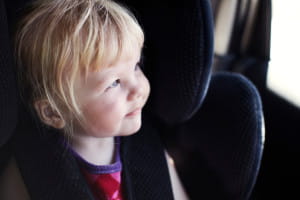Preventing child heatstroke in cars

“Very young children, especially those under the age of four, are particularly susceptible to overheating, or hyperthermia,” explains Lisa Eckenrode, trauma injury prevention and outreach coordinator at Paoli Hospital. “When adults get hot, we will sweat and begin to cool down naturally. Children have a lower sweating ability and can’t cool down as quickly, which makes overheating a much more dangerous issue.”
Eckenrode reminds parents that, while the temperature outside may not feel dangerous, car temperatures can rise quickly. A sunny, 70-degree day outside can cause a car’s temperature to rise to 104 degrees within a half hour. On a 90-degree summer day, that temperature can be even more dangerous, rising to a potential 124 degrees.
While most stories are a result of parents or caretakers mistakenly leaving children in a vehicle, Eckenrode reminds parents that this isn’t the only contributor to heatstroke-related deaths.
“It’s easy for children to gain access to your car when it’s unattended,” she explains. “After you’ve checked the car’s interior for occupants, make sure you lock your doors and keep your car keys and remote openers out of reach of children. A child’s curiosity places them at risk for getting into a vehicle and accidentally triggering the locking system.”
In addition to keeping keys out of reach of children, Eckenrode also recommends a few ways that parents, caretakers, and drivers can remind themselves of a child’s presence in a vehicle and prevent heatstroke deaths, including:
- Placing work materials or a briefcase or handbag in the backseat next to your child so that you will see the child and be reminded of them when you get your possessions, like your wallet or keys
- Placing a child’s toy in the front seat as a reminder of their presence
- Developing a plan with your daycare provider that if your child is not dropped off or picked up within a specific time, you are contacted
- Downloading one of many smartphone apps like Precious Cargo or Kars4Kids Safety to trigger a reminder than you still have passengers in the car
- Never leaving a sleeping child in the car for any amount of time
- Purchasing recently-introduced car seat models that include temperature sensors and alarms when car temperatures reach dangerous levels
And, despite all safety measures and precautions, if you do find yourself in a situation where a child is locked inside of a car on warm day, Eckenrode says you should:
- Call 911 and report the situation
- Stay with the child and try to attract their attention
- Remember to check your watch periodically so you have an idea of how long they have been in the car since your arrival
- If the child is mobile, try to instruct them on how to roll down the window or unlock the door
- If the child is unresponsive or very lethargic, consider breaking a window to gain access to the vehicle
If you do need to break a window, a window punch tool is best, and most police and emergency service providers carry this device. However, in an emergency, any heavy object will do. When breaking the window, always choose the window on the opposite side of the child and furthest away from them to prevent injury.
Nervous about breaking the window of a vehicle that doesn’t belong to you? Currently, 20 states have Good Samaritan laws that allow bystanders who notice a child locked in a vehicle to take action to prevent the death of a child as a result of heatstroke. If you’re unsure of what to do or how to help a child in a locked vehicle, don’t hesitate to call for help.
“Minutes matter in saving the life of a child from heatstroke,” says Eckenrode. “It’s important for everyone, regardless of whether they are parents or caretakers, to understand the symptoms and the risks of heatstroke and how to prevent it.”